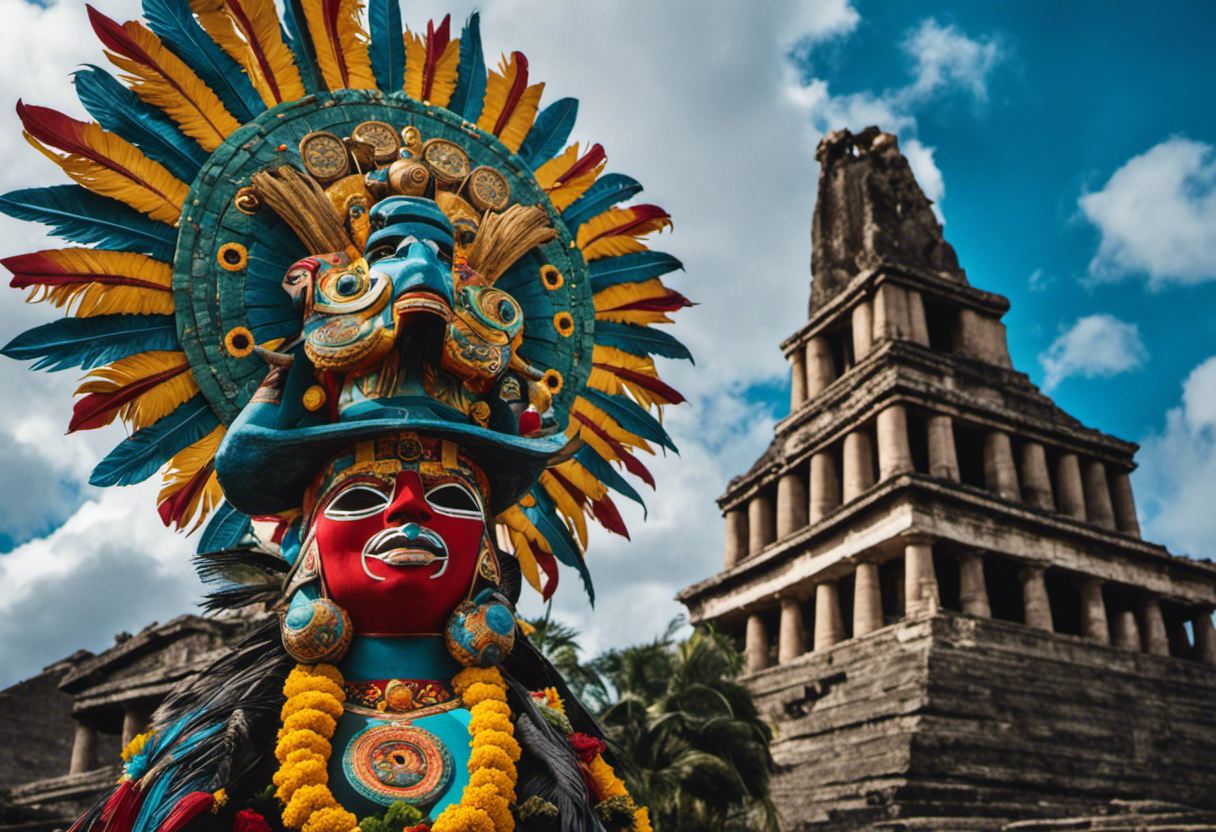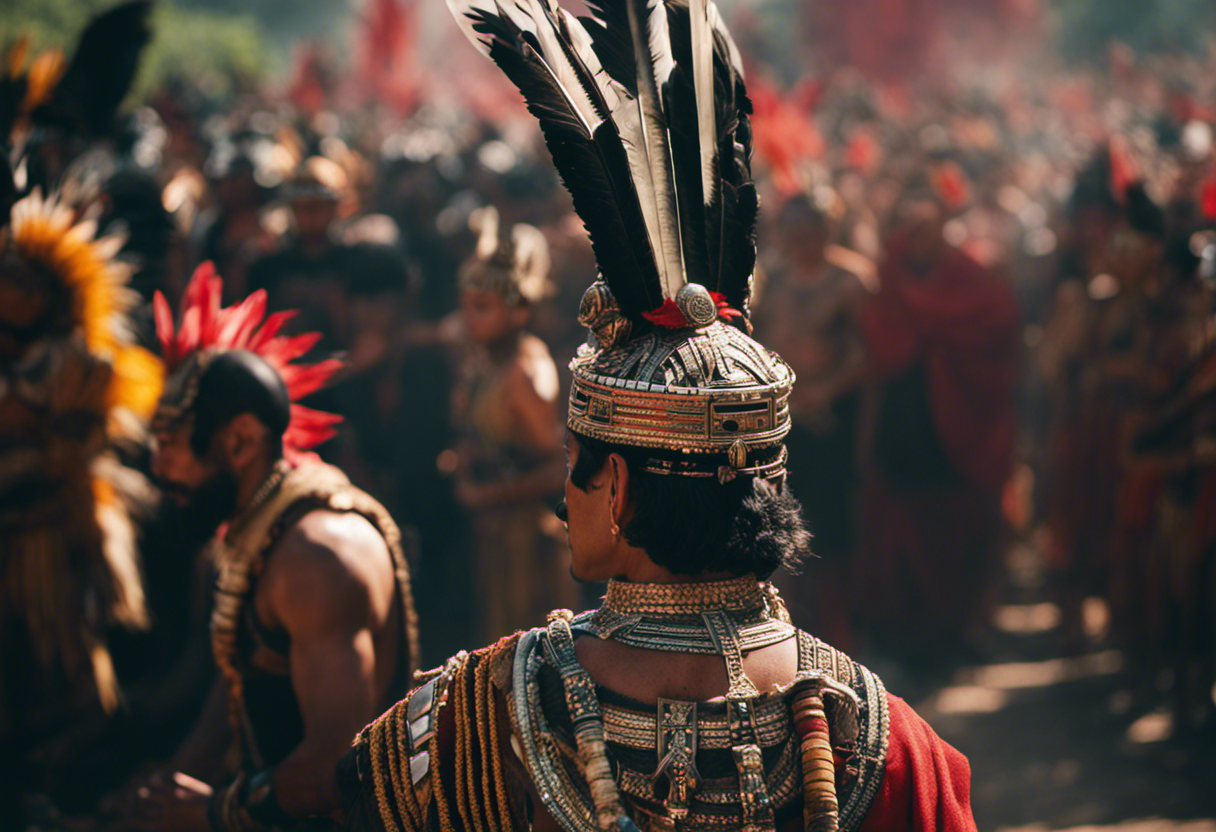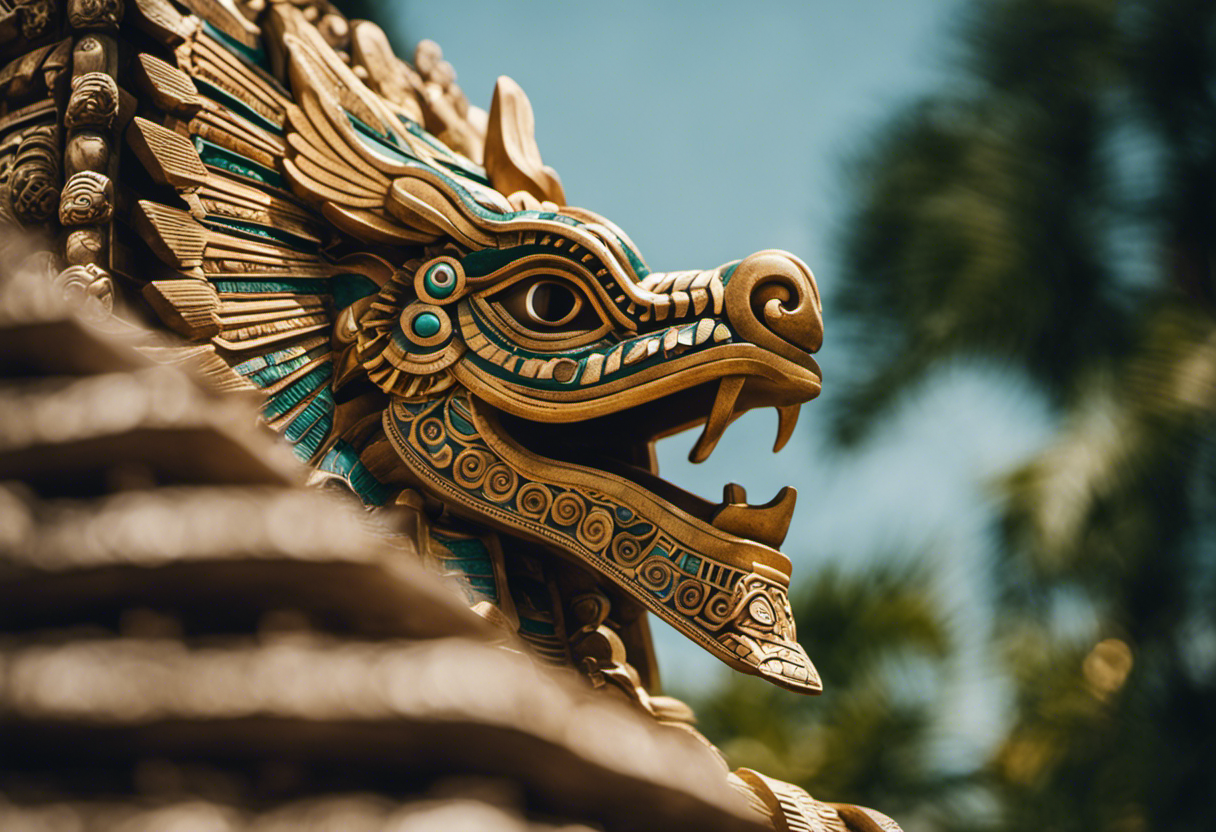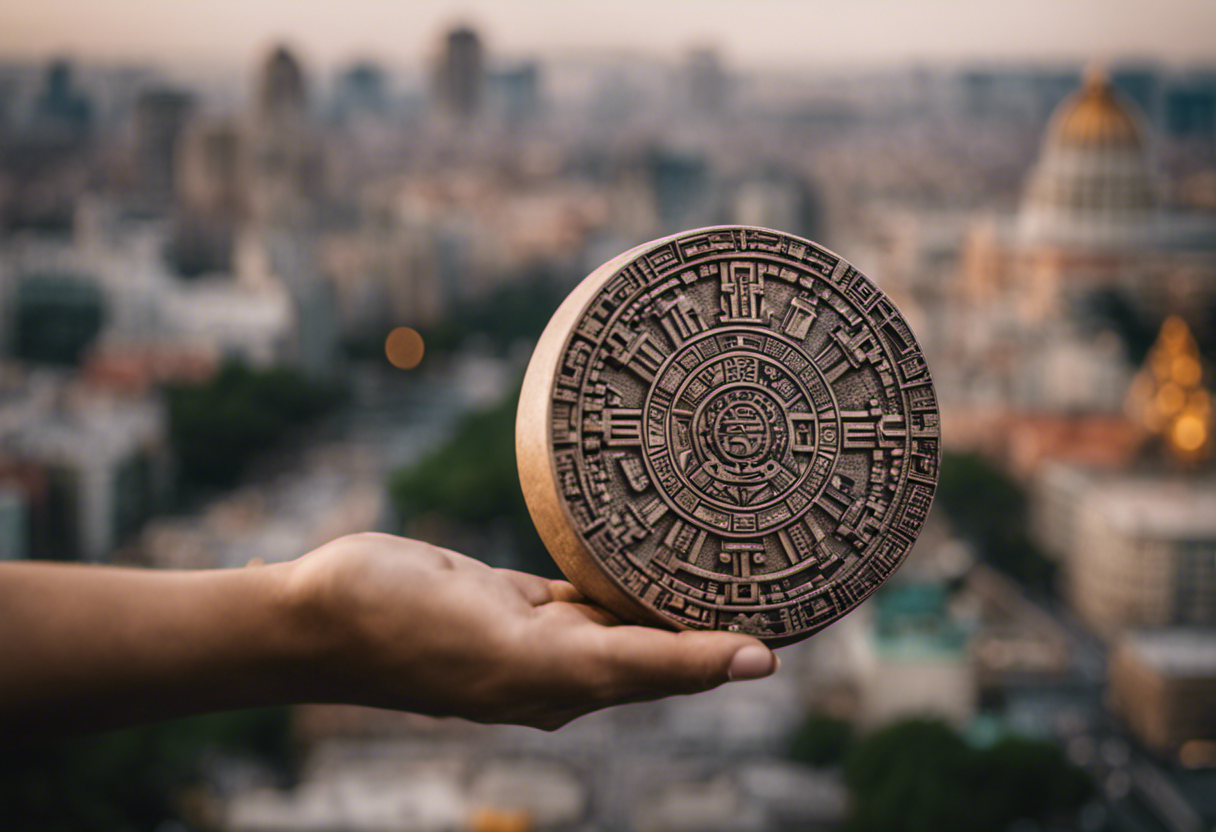The Aztec civilization, known for its rich cultural heritage, presents a fascinating blend of intricate timekeeping and religious beliefs.
Central to their society was the Aztec calendar, a sophisticated system that governed their daily lives.
This article explores the intricate world of Aztec religion, delving into the pantheon of gods and goddesses worshipped by the Aztecs.
Through an objective lens, we will examine the rituals, symbolism, and mythology surrounding these deities, shedding light on the enduring legacy and influence of Aztec religion in modern society.
Key Takeaways
- The Aztec calendar consisted of two interlocking calendars: Tonalpohualli and Xiuhpohualli, which were used for religious ceremonies, divination, and agricultural purposes.
- Aztec religious beliefs centered around the worship of numerous gods and goddesses, who played a crucial role in the daily lives of Aztec society. Prominent deities included Huitzilopochtli, Tlaloc, Quetzalcoatl, Coatlicue, and Xipe Totec.
- Rituals and ceremonies were conducted by priests known as tlamacazqui, and were seen as vital for maintaining society and connecting with the divine. Offerings, prayers, dances, and sacrifices were performed to appease the gods, and ceremonies were held at specific times coinciding with agricultural cycles or celestial events.
- The Aztec pantheon of gods and goddesses was vast and complex, with various divine roles and responsibilities. They were worshipped through rituals and ceremonies, and acted as intermediaries between the mortal world and the divine realm.
The Aztec Calendar: An Ancient System of Timekeeping


Within the realm of Aztec civilization, the Aztec calendar served as an ancient system of timekeeping, guiding the daily lives and rituals of its people. This ancient timekeeping system was of great cultural significance to the Aztecs, as it played a vital role in their religious beliefs and practices.
The Aztec calendar was a complex and intricate system that consisted of two interlocking calendars. The first was the Tonalpohualli, which was a sacred calendar that consisted of 260 days. Each day was represented by a unique combination of a number from 1 to 13 and one of 20 different day signs. This calendar was used for determining the most auspicious days for religious ceremonies, as well as for divination and astrology.
The second calendar was the Xiuhpohualli, or the solar calendar, which consisted of 365 days. It was divided into 18 months, with each month having 20 days. The remaining 5 days were considered unlucky and were known as the nemontemi. This calendar was used for agricultural purposes, such as determining the best time for planting and harvesting crops.
The Aztec calendar had a profound cultural significance for the Aztecs, as it reflected their deep connection to nature and their belief in the cyclical nature of time. It also played a crucial role in their religious rituals and ceremonies, as the Aztecs believed that the calendar was a divine gift from the gods. The precise alignment of the calendar with celestial events such as solstices and equinoxes further emphasized its importance in their spiritual practices.
Understanding Aztec Religious Beliefs


Aztec religious beliefs were centered around the worship of numerous gods and goddesses. These deities played a crucial role in the lives of the Aztec people, and their worship was accompanied by elaborate rituals and ceremonies.
Understanding the intricacies of Aztec religious beliefs provides insight into the cultural and spiritual significance of the gods and the practices associated with their worship.
Gods and Goddesses Worshiped
Many different gods and goddesses were worshiped by the Aztec people as part of their religious beliefs. These deities played a significant role in the daily lives of the Aztec society, with worship practices and rituals devoted to appeasing and honoring them.
Here are five of the most prominent gods and goddesses worshiped by the Aztecs:
- Huitzilopochtli: The god of war and the sun, Huitzilopochtli was highly revered and associated with human sacrifice.
- Tlaloc: The god of rain and fertility, Tlaloc was believed to bring nourishment to the crops and was worshiped through offerings and rituals.
- Quetzalcoatl: Known as the feathered serpent, Quetzalcoatl was associated with creation, knowledge, and fertility.
- Coatlicue: The mother goddess, Coatlicue represented life, death, and rebirth.
- Xipe Totec: The god of agriculture, Xipe Totec was worshiped through ceremonies involving human sacrifice and the wearing of flayed skin.
These gods and goddesses were honored through various religious symbols, such as statues, temples, and sacred rituals, demonstrating the deep spiritual connection the Aztec people had with their divine pantheon.
Rituals and Ceremonies Performed
Engaging in elaborate rituals and ceremonies, the Aztec people sought to connect with their gods and goddesses and ensure the wellbeing of their society. Aztec religious practices were deeply intertwined with their daily lives, permeating every aspect of their society. Rituals and ceremonies played a significant role in maintaining the balance between the physical and spiritual realms.
These practices were conducted by priests, known as tlamacazqui, who were responsible for interpreting the will of the gods and performing the necessary rituals. The Aztecs believed that through these rituals, they could communicate with their deities and receive their blessings and guidance.
Ceremonies were conducted at various times throughout the year, often coinciding with agricultural cycles or celestial events. They involved offerings, prayers, dances, and sacrifices, all aimed at appeasing the gods and ensuring the continued prosperity and protection of the Aztec civilization.
The significance of rituals and ceremonies in Aztec religious beliefs cannot be overstated, as they were seen as vital for the maintenance of their society and their connection to the divine.
The Pantheon of Aztec Gods and Goddesses


The pantheon of Aztec gods and goddesses was vast and complex, encompassing a wide range of divine roles and responsibilities. These deities were worshipped through elaborate rituals and ceremonies, which played a crucial role in Aztec society.
The gods and goddesses held significant influence over various aspects of life, from agriculture and fertility to warfare and death.
Divine Roles and Responsibilities
Within the complex belief system of the Aztecs, the gods and goddesses played essential dual roles as both creators and guardians of the natural and spiritual realms. These divine beings held various responsibilities and were revered in religious practices.
Here are five key aspects of their divine roles and responsibilities:
- Creation: The gods and goddesses were responsible for creating the world and all living beings.
- Protection: They served as protectors of the Aztec people, their crops, and their cities.
- Rituals and Offerings: The gods and goddesses required regular rituals and offerings to maintain harmony and ensure the well-being of the people.
- Transformation: They had the power to change forms and often appeared in animal or hybrid forms.
- Intercession: The gods and goddesses acted as intermediaries between the mortal world and the divine realm, relaying prayers and requests.
These divine roles and responsibilities were deeply intertwined with the daily lives and religious practices of the Aztec people.
Worship and Rituals
Numerous worship ceremonies and rituals were an integral part of Aztec religious practices, highlighting the extensive pantheon of gods and goddesses revered by the ancient civilization. The Aztecs held celebratory festivals throughout the year to honor their deities, with each god and goddess having their own specific day or month dedicated to them.
These festivals were marked by elaborate rituals, which included music, dance, processions, and offerings. Sacrificial offerings played a significant role in Aztec worship and rituals. The Aztecs believed that blood was a sacred and powerful substance, and they offered human and animal sacrifices to appease their gods and ensure the continuity of life.
These sacrifices were often conducted on top of pyramids or in temples dedicated to specific deities, and they were seen as a way to maintain the cosmic balance and prevent catastrophes.
Influence on Society
Throughout Aztec society, the pantheon of gods and goddesses exerted a profound influence, shaping every aspect of daily life and serving as the foundation for religious, political, and social structures. The Aztec religion was not limited to worship and rituals alone but permeated the fabric of society.
Aztec religious practices in daily life were deeply ingrained, with individuals offering prayers and making sacrifices to the gods on a regular basis.
The gods and goddesses were believed to control natural forces, such as the sun, rain, and agriculture, which directly impacted the livelihoods of the Aztec people.
The pantheon of gods and goddesses also influenced political structures, as rulers claimed divine authority and were seen as intermediaries between the gods and the people.
Aztec religious beliefs and practices continue to influence modern art, with many contemporary artists drawing inspiration from the rich mythology and iconography of the Aztec gods and goddesses.
The prominence of the pantheon in Aztec society fostered a sense of community and collective identity, as individuals participated in communal rituals and festivals to honor the gods.
Rituals and Ceremonies in Aztec Religion


Frequently practiced by the Aztec people, rituals and ceremonies played a significant role in their religious beliefs and traditions. Aztec rituals were a way for individuals to communicate with the gods and seek their blessings. They believed that performing these rituals would ensure the balance of the natural and supernatural worlds. Aztec ceremonies were often held in temples or sacred spaces, and were led by priests who were responsible for maintaining the connection between the people and the gods.
One of the most important rituals in Aztec religion was the offering of human sacrifices. It was believed that these sacrifices were necessary to appease the gods and ensure the continued existence of the world. The Aztecs would capture prisoners from rival tribes and bring them to the top of their temples, where their hearts would be cut out as an offering to the gods.
Other rituals and ceremonies included the worship of specific gods and goddesses, such as the goddess of fertility and agriculture, Tonantzin, and the rain god, Tlaloc. These ceremonies often involved elaborate processions, music, dancing, and feasting.
Symbolism and Mythology of Aztec Deities


What are the key symbols and myths associated with Aztec deities?
The symbolism and mythology of Aztec deities played a central role in the religious practices and beliefs of the Aztec civilization. These deities were represented through various symbols in art and were an integral part of rituals in everyday life.
Here are some key symbols and myths associated with Aztec deities:
- Quetzalcoatl: The feathered serpent deity was often depicted with vibrant feathers and a serpent’s body, symbolizing the union of earth and sky. Quetzalcoatl was associated with creation, wisdom, and fertility.
- Huitzilopochtli: The god of war was commonly depicted with a blue face and a headdress adorned with hummingbird feathers. Huitzilopochtli symbolized the sun, strength, and the Aztec people’s determination to defend their civilization.
- Tlaloc: The rain god was often depicted with goggle eyes and fangs, representing his association with water and fertility. Tlaloc was believed to bring rain and agricultural abundance.
- Xipe Totec: The god of agriculture and renewal was represented by a figure wearing the flayed skin of a sacrificial victim. This symbolized the shedding of old skin and the rebirth of nature.
- Coatlicue: The mother goddess was portrayed as a fearsome figure with a skirt made of serpents and a necklace of human hearts. Coatlicue symbolized life, death, and the cyclical nature of existence.
These symbols and myths served as a means to understand and connect with the divine, as well as to reinforce the importance of rituals and ceremonies in the everyday life of the Aztec people.
Legacy and Influence of Aztec Religion in Modern Society


Having endured the test of time, the Aztec religion continues to exert a profound influence on various aspects of modern society. The legacy and practices of this ancient religion have had a lasting impact on the cultural significance of the Aztec civilization.
One of the most prominent ways in which the Aztec religion has influenced modern society is through its impact on art and architecture. The intricate carvings and sculptures found in Aztec temples and pyramids continue to inspire contemporary artists, while their unique architectural style has been replicated in modern buildings.
Furthermore, the Aztec religion has also influenced the spiritual beliefs and practices of indigenous communities in Mexico. Many of these communities still incorporate elements of Aztec rituals and ceremonies into their own religious practices, demonstrating the enduring legacy of the Aztec religion.
In addition, the Aztec calendar, with its complex system of timekeeping and religious significance, has also left a lasting impression on modern society. Its symbols and images have been incorporated into various forms of art, jewelry, and even tattoos, serving as a reminder of the rich cultural heritage of the Aztecs.
Conclusion
In conclusion, the Aztec calendar and religion offer a fascinating glimpse into the ancient civilization’s complex beliefs and practices. Despite the passage of centuries, their gods and goddesses continue to captivate our imagination and inspire modern culture.
The rituals and ceremonies associated with Aztec religion were deeply symbolic and held great importance in their society.
While their mythology and deities may seem distant and unfamiliar to us today, their legacy remains an enduring testament to the power of human imagination.




